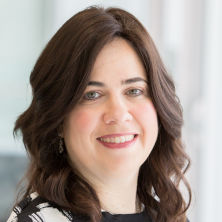Supply-Chain Researcher Penina Orenstein is on a Mission to Mine Higher-Quality Data
Friday, November 11th, 2022

Associate Professor Penina Orenstein, Ph.D.
The COVID-19 pandemic was responsible for widespread disruption of national and global supply chains, due to changing demand for products, labor shortages and other factors. Since then, the Russia-Ukraine conflict has further complicated freight, cargo and transport logistics. But the pandemic revealed how supply-chain risks can vary wildly from one company to the next, even those within the same industry.
“Nike, for example, really suffered a dip in their supply chain profits while Adidas did not,” says Penina Orenstein, Ph.D., a Seton Hall Stillman School of Business Associate Professor of Computing and Decision Sciences. “Why does one company suffer a big downturn when another does not? We’re looking at pre- and post-pandemic supply chain structures to find out why some supply chains are more resilient than others.”
Orenstein tends to see supply chains and network systems in everything around her. As a Ph.D. student studying mathematical networks, she did her thesis on traffic bottlenecks and congestion. That networks approach led her to manage wireless telecommunications for AT&T until 2006, when she was recruited to Stillman to lead coursework and research in supply chains.
“Initially, my work focused on figuring out the structure of supply chains. Now, my energy is shifting to data: how do we marry business analytics with supply chains?” she says. “Data-related challenges are definitely the driving force behind how my research in this space is evolving.”
The data focus has also intrigued many Seton Hall students to get involved with Orenstein’s research. “A large number of business students are interested in collecting, organizing and visualizing supply chain data,” she says. Stillman M.B.A. students tend to help Orenstein with background work while students pursuing a master’s in business analytics or data science tend to gravitate toward the programming and analysis components of mapping out supply chains.
One of her former students, Samuel Kihuguru, developed a new piece of software that collects a company’s supply chain data in 10-year chunks, breaks it down into annual quarters, and then filters through all vendors to eliminate the ones that don’t supply material goods.
“Oracle, for example, is listed as a supplier for Nike, but it’s not contributing to their supply-chain bottom line,” Orenstein says. Typically, supply-chain maps don’t have vendors ranked or categorized by whether they contribute material goods or services, or other non-tangible services. “It means usually you’re going to have a lot of noisy data.”
Kihuguru, who was pursuing a Bachelor of Science degree in Mathematical Finance and Information Technology at the time, received an undergraduate research award for his efforts on the software program. Today, he works at JPMorgan Chase as a public finance products data analyst, but still collaborates with Orenstein’s research group, helping students use his program for their research.
“Data is what drives the supply chain, and the data we collect about supply chains drives the quality of our research,” Orenstein says.
She has published several important papers on supply chain management in recent years, including “The changing landscape of supply chain networks: an empirical analysis of topological structure” (2021) in INFOR: Information Systems and Operations Research; “Identifying the relation between a supply chain network’s structure and its overall financial performance” (2021) in Operations and Supply Chain Management: An International Journal; “A digital mapping paradigm to identify supply chain network structure and evolution” (2019) in International Journal of Operations and Quantitative Management; and “What are the key drivers of future Supply Chains?” (2016) in Journal of Accounting, Business and Management (JABM).
Her peer-reviewed research directly addresses the supply-chain challenges driving inflation and production constraints today, and drives innovation to better serve companies and consumers.
Orenstein is also an advocate for women in academia. “I’m a mother of a large family, and I have several grandchildren. Managing my family is a bit like managing a supply chain … it’s an economy of scale,” she laughs.
“It’s a lot of fun having a big family and working at Seton Hall facilitates my ability to give back to Seton Hall, do research, teach and grow my family. I’ve had students come up to me and say I’m their role model, that they want to pursue a career in academia and also have a big family. I smiled to know I may have encouraged other women to think that they can do this, too.”
Categories: Business





